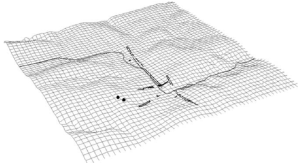
Courtesy H P Chapman
& Oxford Journal of Archaeology, 2003
Rudston has evidence of continuous inhabitation for millennia and is thought to be the oldest continuously inhabited village in England. There are square and round barrows with numerous Neolithic and Bronze Age burials. Unfortunately, many of the excavations were carried out in the 19th century and due to the methods of "archaeology" used, little remains of the content.
To the north of the village are Argam Dikes, prehistoric earth banks that are quite difficult to spot nowadays. Of national importance is the the Woldgate Cursus, believed to be late Neolithic earth banks, which may have been track ways or procession paths . Also discovered were many Iron Age graves to the north of Rudston towards Burton Fleming; much excavation was carried out there during the 1970's.
More information can be found here:
An English Heritage project is currently being carried out to reassess the 150 identified cursuses in England and build an understanding of why they were created. Initial thoughts are that they were processional routes, designed to include the monuments and the events taking place into the natural world around them. A possible alternative is that they were routes for young men to traverse as a rite of passage - linking the name back to its William Stukeley's original thought of them as race courses. Further information may be found on the English Heritage website.
Evidence has also been found of the Roman occupation of the village. The remains of a Roman Villa, complete with a 9' by 4' mosaic floor showing Venus bathing, was uncovered during excavations in the 1930's. This pavement, comprising 1" square tesserae in blue, red and grey, is on display in the Hull & East Riding Museum in Hull. The lead archaeologists were Arthur Woodward and later Kenneth Steer. Various Roman artefacts were also discovered in the 1830s when the Thorpe Hall fishponds were excavated.